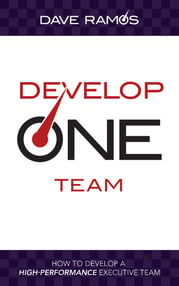DEVELOP ONE TEAM
SHIFTPOINTS® helps CEOs unleash the accelerating power of Executive Team Alignment (ETA).
Our methodology is radically different from traditional executive coaching.
No silly games. No navel gazing. No touchy-feely psychobabble.
We are intensely focused on helping executive teams deliver results.
One Vision. One Strategy. One Goal. One Team.
THE DEVELOP ONE TEAM™ METHODOLOGY
To help our clients develop high-performance executive teams, we created the Develop One Team™ methodology. It has seven components that we call, The Seven Disciplines™:
1. THE RIGHT PEOPLE
The first component of our methodology focuses on the people on the executive team. Some of the key questions we examine include:
- Who is on the executive team?
- Why are they on the team?
- Does the team have the competencies required to win?
- Does every executive have a formal, written development plan?
2. THE RIGHT DESIGN
The second component of our methodology focuses on the design of the executive team. Some of the key questions we examine include:
- How is the team organized?
- Who is in the "inner circle?"
- Is everyone in the right role?
- Are there any people who should be added to the team?
3. THE RIGHT DYNAMICS
The third component of our methodology focuses on the dynamics of the executive team. Some of the key behaviors we examine include:
- Does the executive team communicate effectively?
- Does the executive team resolve conflict in a healthy way?
- Does the executive team operate with psychological safety?
- Do the members of the team trust each other?
4. THE RIGHT DECISIONS
The fourth component of our methodology focuses on the decisions of the executive team. Some of the questions we ask include:
- Does the executive team have productive debates?
- Does the executive team have clearly defined decision rights?
- Does the executive team make effective decisions?
- Does the executive team align behind decisions?
5. THE RIGHT DELIVERABLES
The next component of our methodology focuses on the deliverables of the executive team. For example, executive teams must collaborate to deliver:
- A clear, compelling vision
- A winning strategy
- An effective organization structure
- An optimized budget that allocates human and financial resources to the right priorities
6. THE RIGHT DIRECTION
The sixth component of our methodology focuses on the how the executive team maintains direction. For example, executive teams must:
- Clearly communicate goals and priorities
- Create a "one-company" culture
- Design and implement an efficient Alignment Management System (AMS)
- Align everyone—and everything—in the organization to win
7. THE RIGHT RESULTS
Finally, SHIFTPOINTS is intensely focused on helping executive teams deliver results. This starts with clarifying exactly what the executive team is expected to achieve. Then, we help executive teams stay aligned and accountable to ensure that they deliver them.
Our best clients have grown tenfold! Some have quadrupled in size. Many have doubled. One is in the Inc. 5000 Hall of Fame.
To learn how to achieve these results for your organization, request a free consultation.
EXECUTIVE TEAM ALIGNMENT (ETA)
We believe that your corporate executive team is ultimately responsible for creating alignment.
Therefore, Step One is for them to accept that responsibility.
This starts with your CEO. Your CEO must operate as the company’s Chief Alignment Officer.
Second, the entire corporate executive team must embrace alignment as a critical corporate initiative. There are several reasons for this:
- The corporate executive team is ultimately responsible for aligning the company’s multiple divisions, departments, functions, and geographies. Often, these groups operate very independently from one another on a day-to-day basis and only come together at executive team meetings.
- The corporate executive team is ultimately responsible for aligning the interests of the company’s multiple stakeholders. These stakeholders include investors, creditors, employees, boards, vendors, customers, governments, the communities where you operate, and more. These stakeholders often have competing interests which must be aligned.
- The corporate executive team is ultimately responsible for aligning the company’s multiple strategies, tactics, goals, priorities, and initiatives into a coherent corporate strategic plan (One Plan).
- The corporate executive team is ultimately responsible for aligning the company’s resources—both human and financial—with the corporate strategy. Budgets must be allocated. Headcounts must be approved.
- Each corporate executive has the responsibility to align their functional area. The Chief Financial Officer must consolidate the budgets. The Chief Marketing Officer must integrate the marketing plans. The Chief Sales Officer must roll up the sales forecasts.
Finally, the corporate team “sets the bar” for alignment. If they are not aligned as One Team, the rest of the organization will be dysfunctional. They must be role models for alignment. A misaligned executive team will never create an aligned company.
Let me say that again. A misaligned executive team will never create an aligned company.
That is why we start every engagement with The Navigation Index™, our assessment of Executive Team Alignment (ETA).
EXECUTIVE GRADE
GMC Trucks has a slogan, “We are professional grade.” (A great brand position, by the way.)
High-performance organizations are led by people who are “executive grade.”
These executives demonstrate a rare mix of skills, abilities, and behaviors. Here are some of the most important ones:
- Executive-grade results. First and foremost, executives deliver executive-grade results. They sign up for “the big number” and then build organizations to deliver it. They earn the organization’s respect … not because of their position, but because of their results.
- Executive-grade strategic thinking. It has been said that, “leaders are readers.” Executive-grade strategic thinking is driven by continuous learning, reading, seminars, etc. The best executives are humble enough to know that they don’t know everything … and that humility fuels their quest for knowledge.
- Executive-grade perspective. Executives have a breadth of perspective that extends beyond their departmental responsibility. They understand the interdependencies of all elements of the organization, and understand that the needs of the organization supersede the needs of their own department.
- Executive-grade expertise. Executives have functional expertise developed at the highest level. They are truly one of the best-in-the-world at their function. This deep expertise allows them to recruit top talent for their departments … because the best want to work for the best.
- Executive-grade communications. Executives are polished communicators. They know what to say, and how to say it. They have a mastery of language which allows them to paint compelling word-pictures to inspire followers to charge the hill.
- Executive-grade energy. Being an executive is not a 40 hour / week job. Executives must set the example, working long and hard. They must attend social functions on nights and weekends. They travel, often extensively. Therefore, they must have high energy levels and a “big tank.”
- Executive-grade decorum. Executives realize that they are always “on-stage.” Therefore, they conduct themselves with decorum. They dress appropriately. They use appropriate language. They only discuss things that are appropriate … with the appropriate people.
- Executive-grade networking. Executives build relationships with other senior executives. They have a unique ability to connect and leverage those connections to create value for their organizations. This deep, executive-grade rolodex is one of their greatest assets.
- Executive-grade decision making. Executives are forced to make tough decisions. In fact, if the decision is easy, it probably should have been made by someone lower in the organization. To make the tough decisions, executives apply wisdom to gather information, evaluate the options, and make the call.
- Executive-grade development. Executives must be developers of people. They must have an innate ability to spot talent and potential in others, and then invest themselves in helping people develop to the maximum of their potential. Often, they see developing people as their greatest achievement.
To win, your organization must develop leaders who are truly “executive grade."









